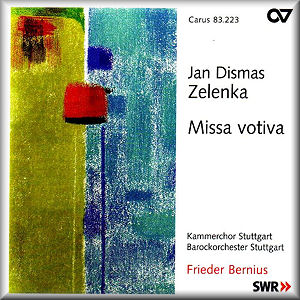 |
 |
|


alternatively
CD: MDT
AmazonUK
Sound
Samples & Downloads
|
Jan Dismas ZELENKA (1679 - 1745)
Missa votiva in e minor (ZWV 18)
 Joanne Lunn (soprano), Daniel Taylor (alto), Johannes Kaleschke
(tenor), Thomas E. Bauer (bass)
Joanne Lunn (soprano), Daniel Taylor (alto), Johannes Kaleschke
(tenor), Thomas E. Bauer (bass)
Kammerchor Stuttgart, Barockorchester Stuttgart/Frieder Bernius
rec. 7-9 July 2008, Evangelische Kirche of Reutlingen-Gönningen,
Germany. DDD
 CARUS 83.223 [69:15]
CARUS 83.223 [69:15] 
|
|
|
Jan Dismas Zelenka was one of the best composers of
his time, whose works were highly appreciated by Johann Sebastian
Bach. His life was however touched with tragedy. In 1710 or
1711 he was appointed as a double-bass player in the court orchestra
in Dresden, but soon he also became active as a composer. In
the dedication of his first mass to the Elector August the Strong
he asked for permission to go to Italy and France to broaden
his musical horizons; this request wasn't granted. The Kapellmeister
at the time was Johann David Heinichen, who in the 1720s often
fell ill, and whose duties had to be taken over by Zelenka.
When Heinichen died in 1729 Zelenka hoped to be appointed as
his successor. But his hopes were dashed when in 1733 Johann
Adolf Hasse got the job instead.
It is not known for sure why Zelenka was passed over, but it
seems likely that his style of composing was considered old-fashioned,
whereas Hasse was more modern and would be a better fit with
the fashion of the time. The fact that Bach admired his music
is an indication of Zelenka's preference for a 'learned' style,
in which traditional German counterpoint played an important
role. Zelenka's many compositions, in particular his religious
works, impressively show how well he mastered counterpoint and
how he was able to merge the tradition with modern concertante
elements. There are even some traces of the galant idiom in
his oeuvre.
In the 1730s Zelenka continued to compose religious music but
it wasn't often performed during services. The Missa votiva
was the first of six masses which Zelenka aimed to compose;
only four were actually written. It is likely that these masses
were not written for liturgical performance but rather for personal
reasons, probably comparable to Bach's last works, like the
Kunst der Fuge and the Mass in B minor. At the beginning of
the Missa votiva Zelenka wrote a motto: "Vota mea
Domino reddam" (I will fulfill my vows to the Lord). A
postscript on the last page of the score says, again in Latin:
"Jan Dismas Zelenka composed this mass to the greater glory
of God because of a vow, after he had regained his health with
the help of God".
Zelenka's music is always good for a surprise or two, and the
audience is often set on the wrong track. The opening section
of this mass, Kyrie eleison, for instance, begins in a surprisingly
jubilant mood, but then suddenly takes a sour turn with a descending
passage which is to return time and again. This section is parodied
in the closing "Dona nobis pacem". Also notable is
the lamento character of "Et incarnatus est" in the
Credo, prefiguring of the following "Crucifixus".
In the first section of the Credo the intonation of the opening
words, "Credo in unum Deum", is embedded in the overall
texture, and repeated several times through all the voices,
from soprano to bass. In the episode "Et iterum verturus
est" (and he shall come again with glory, to judge both
the quick and the dead) the flow of the music suddenly comes
to a halt, and after a general pause moves on very slowly on
the words "et mortuos" (and the dead). At the end
the same happens on "mortuorum" ([and I look for the
resurrection] of the dead).
It seems unlikely that Bach knew this particular mass, but he
would certainly have appreciated the symmetrical structure of
the Gloria. It is divided into seven sections, beginning and
closing with two tutti episodes. Two solo arias, for soprano
and bass respectively, embrace the central section, again for
the tutti. This section, "Qui sedes", is split into
two contrasting episodes: "Qui sedes ad dexteram Patris",
in a vivid rhythm, with a remarkable unisono passage, and "miserere
nobis", which is full of dissonance and contains frequently
repeated chords in the orchestral parts.
Several tutti sections have solo episodes; the tenor is only
involved in these. The soprano has three solos: Christe eleison
(Kyrie), Qui tollis peccata mundi (Gloria) and the Benedictus.
Joanne Lunn sings them impressively, with excellent diction
and a very precise delivery. Daniel Taylor gives a moving performance
of "Et incarnatus est", and captures the Affekt
of this episode perfectly. Thomas Bauer sings "Quoniam
tu solus sanctus" (Gloria) alright, although he tends to
go a little over the top, and uses a shade too much vibrato.
That is also the case in his solo in "Et resurrexit".
The Stuttgart Chamber Choir is one of the best in the world,
and that again shows in this recording. Consisting of eight
sopranos, six altos, five tenors and five basses, it produces
a beautiful, strong yet transparent sound, and the text is clearly
audible. Zelenka's orchestral parts are always interesting,
and the Stuttgart Baroque Orchestra performs them with flair
and understanding.
Zelenka's music never disappoints, and I don't hesitate to label
this mass a masterpiece. The performance displays this work
in its full glory. Of all recordings of Zelenka's music this
disc is one of the best.
Johan van Veen
|
|
|

